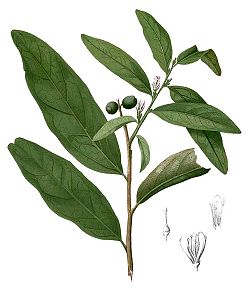| Olax | |
|---|---|
 | |
| Olax imbricata | |
| Scientific classification | |
| Kingdom: | Plantae |
| Clade: | Tracheophytes |
| Clade: | Angiosperms |
| Clade: | Eudicots |
| Order: | Santalales |
| Family: | Olacaceae |
| Genus: | Olax L. (1753) [1] [2] |
| Synonyms [3] | |
| |
Olax is a plant genus in the family Olacaceae. It includes 52 species native to the tropics of South America, Africa, Asia, and Australia. [3] The name derives from the Latin, olax (malodorous), and refers to the unpleasant scent of some of the Olax species. [4] Olax is an Old World genus represented by several climbers, some species have leaves and fruits smelling of garlic such as Olax subscorpioidea and Olax gambecola , seeds of the latter are used as condiments in parts of West Africa. In India Olax nana is well known as one of the first species to emerge after forest fires, the shoots growing directly from buried roots. [5]




